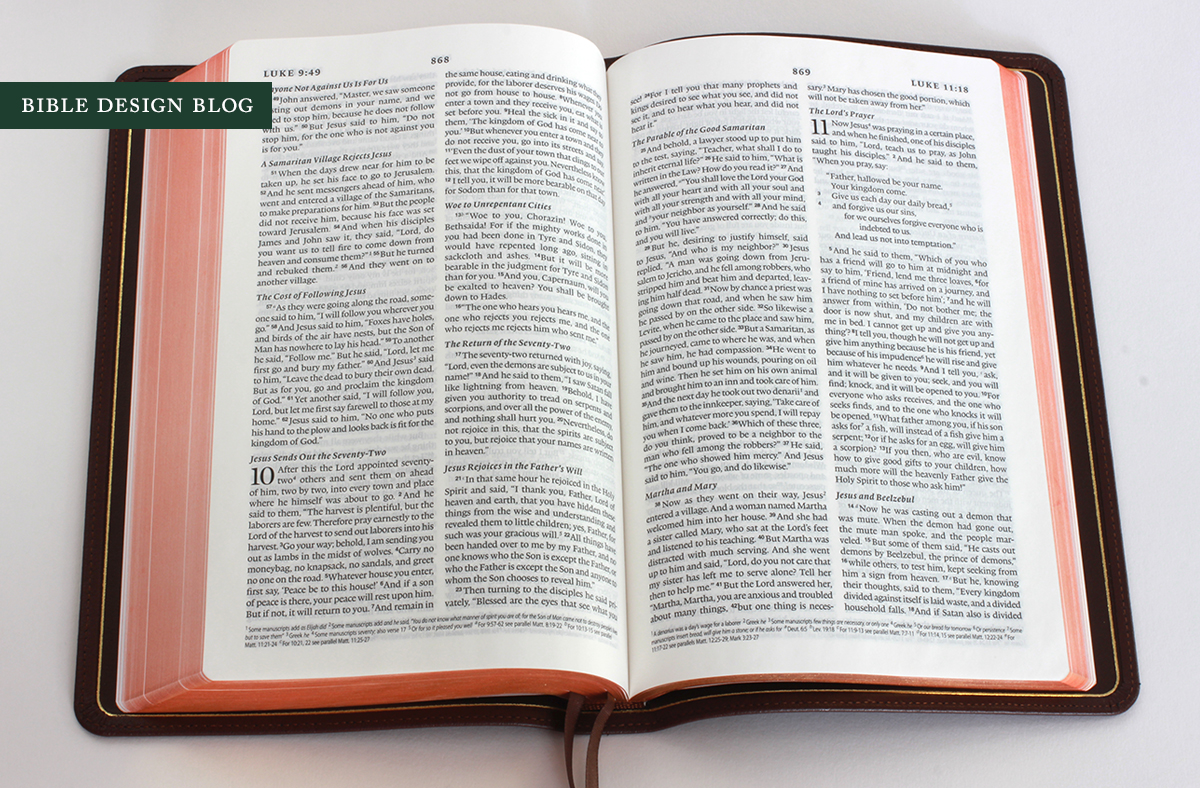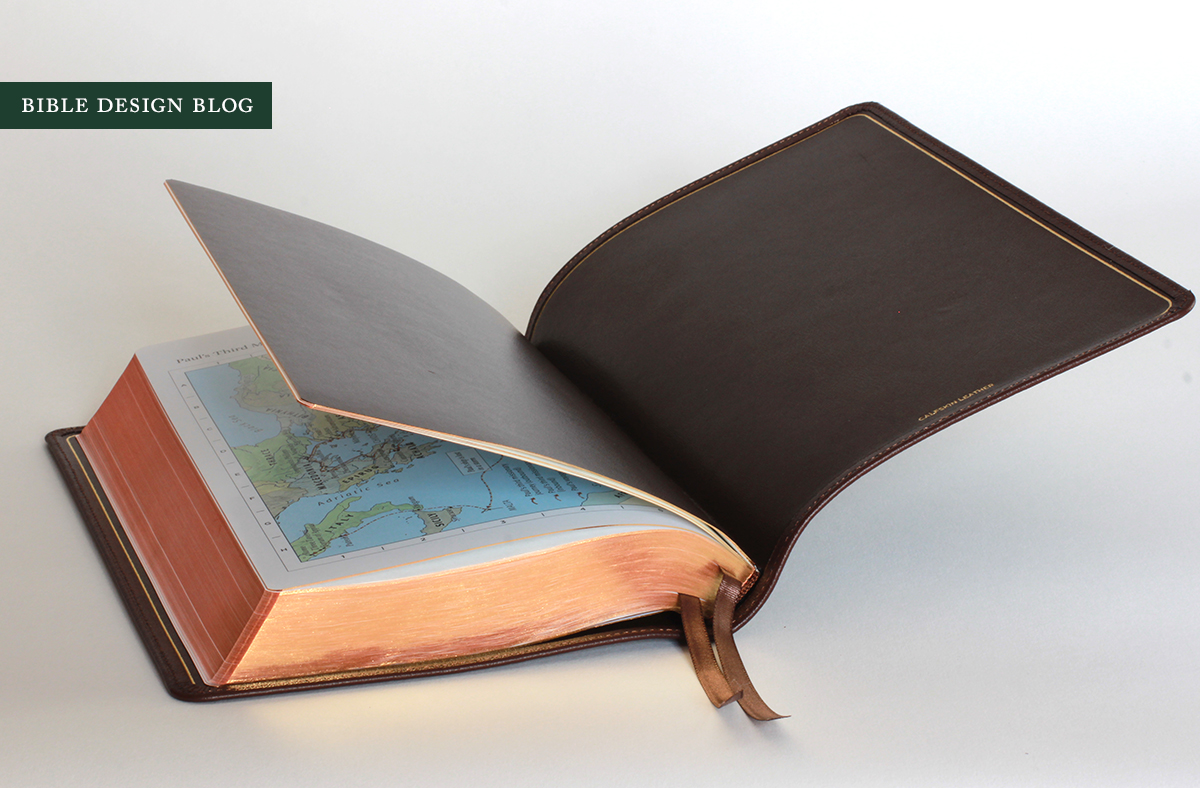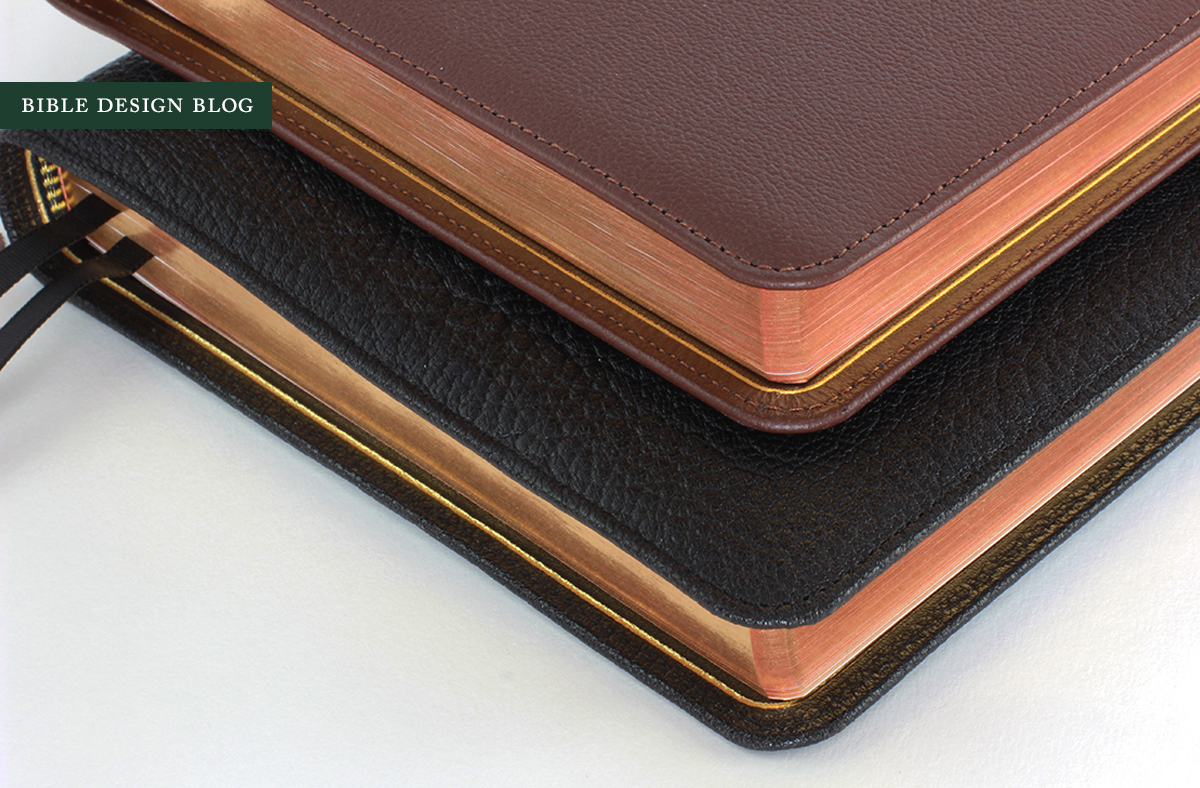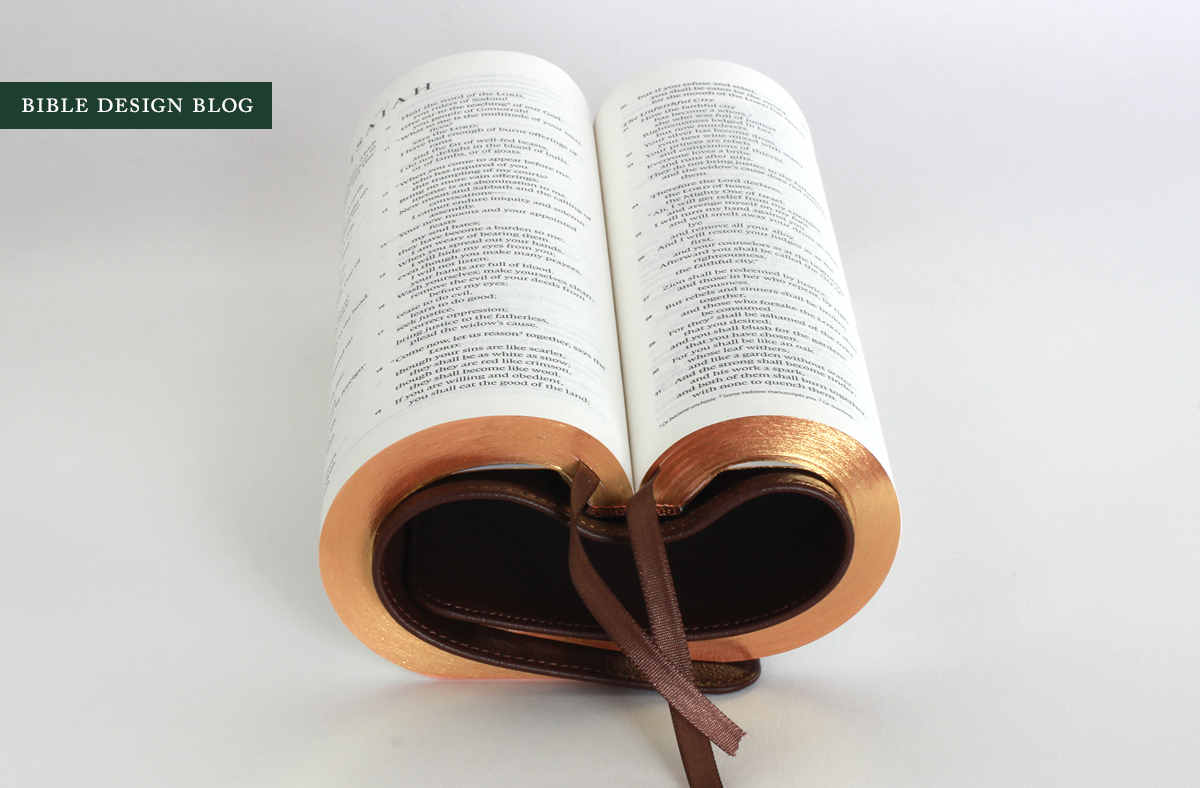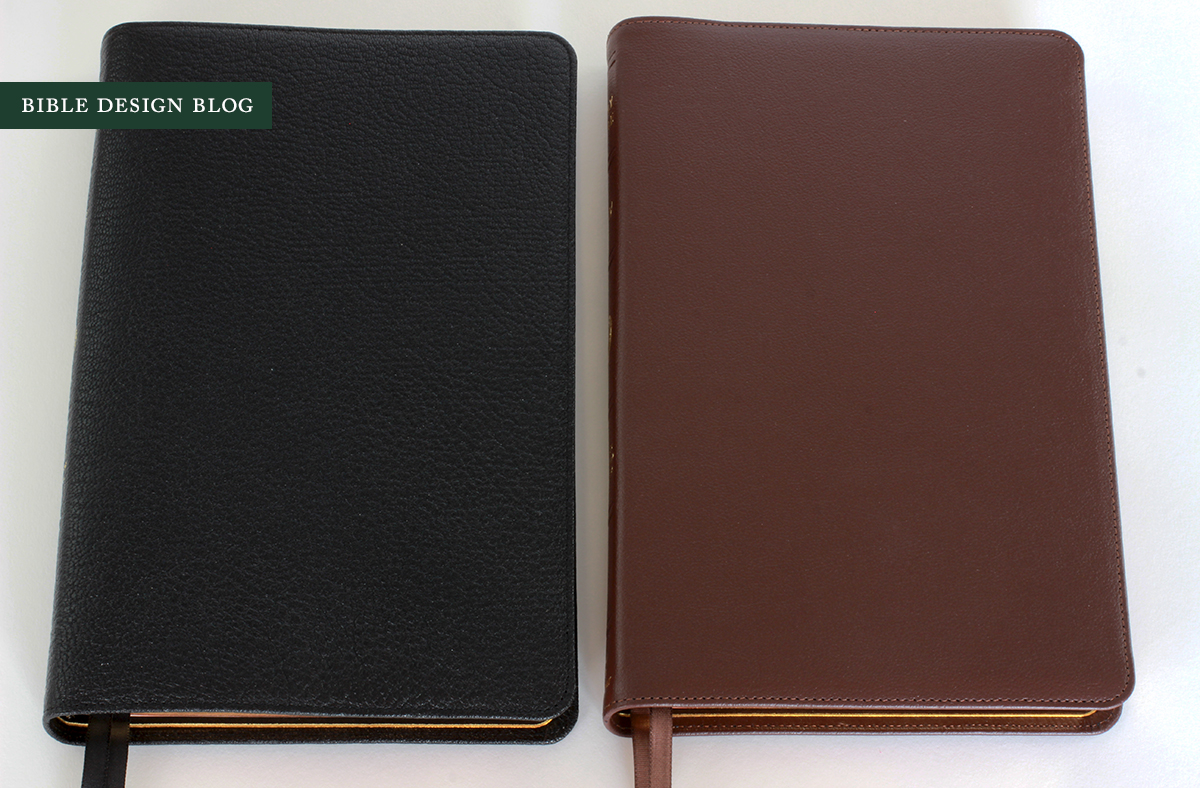Crossway Heirloom Thinline Bible (ESV) in Brown Calfskin and Black Goatskin
I've always had a soft spot for Crossway's thinline editions, which jettison center column references in favor of wider, more readable columns. The first Bible I ever had rebound was a Crossway thinline -- with a glued spine, no less. The Heirloom Thinline is perhaps the best thinline Crossway has produced before, and you can chalk that up to a single factor: Jongbloed. The celebrated Dutch firm is responsible both for the printing and binding of this edition, ensuring quality throughout. People who've bought the Heirloom Thinline have sent me glowing e-mails. They love this Bible. So do I ... though I have a reservation or two, as you'll find out.
DESIGN NOTES & PAPER
If you're familiar with Crossway thinlines, the Heirloom holds no surprises inside. It's a traditional double column, paragraphed text setting featuring 8 pt. type. Line-matching in my copies is mostly good, though I was able to find several examples where the the lines were off. Both the brown calfskin and the black goatskin editions are black-letter, meaning the words of Christ are not set apart with red ink.
One of the downsides of double column settings now that paragraphed text and poetic versification are the norm is that the columns are typically too narrow to render the verse as intended. Instead the lines are chopped short, often in unsightly ways. Perhaps my preference for the Crossway thinlines comes from the fact that, while they still manifest this trait, it's less pronounced than in the editions featuring center column references (which have correspondingly thinner text columns).
I'm not sure what the paper spec is on the Heirloom Thinline, but it reminds me of the paper used in the Cambridge Clarion. There's a comparable level of show-through, I think. (If others have made this comparison, I'd love to hear what your take.) Some people really hate the Clarion's paper, but I'm not one of them. I have one of the originals, complete with curling page edges, and I adore it. If you don't like the Clarion, paper wise, I don't think you'll like the Heirloom, either.
BINDING
The Heirloom Thinline's 6" x 9" form factor corresponds to the size of a large trade paperback, and it's about an inch thick. This makes it thin without being one of those big, floppy thinlines people freak out over. It's a portable, elegant package that doesn't call attention to itself. Both covers, calf and goat, feature stitching around the edge to reinforce the cover, and both have a gilt line inside the cover, art-gilt pages, and two matching ribbons. The black cover has a black lining and the brown cover, I'm pleased to say, has a brown lining.
My issue with the binding, however, is that neither of my copies really opens flat. The culprits, as the photos illustrate, are the reinforced hinges on either side of the book block, which remain stiff despite my best efforts (bordering on abuse) to break them down.
In the photo above, look at the gap between the cover and book block near the spine. Something's holding the book block up, preventing it from opening fully. Below you see the result of trying to open the Heirloom Thinline flat. Because the book block doesn't open up, there's no weight to keep the cover down.
The next photo, which depicts the endpapers on the black goatskin edition, shows what I mean by "hinge." There's a thick half-inch section where the papers meet the spine, with very little give. I assume this is some kind of reinforcement meant to add to the book's longevity. That's fine and all, but if it interferes with the book opening flat, no thanks.
My question for those of you who have Heirloom Thinlines: do you have similar issues with the hinges, or have you managed to break them in? Inquiring minds want to know.
Leaving that one fault aside, I love the leather bindings, in particular the brown calf (which is a bit darker in life than these photos suggest). Unless you're dead set on black, I recommend the brown as having a neat tactile surface I don't recall encountering before. Both versions have slightly thicker covers than I expected, too.
As the Bible yoga photo below suggests, while the Heirloom Thinlines are flexible, they aren't liquid or limp. I'm not sure if it's the cover thickness, the hinge, or both, or something else. These are sturdier volumes, reminiscent of a large format Pitt Minion. For those of you who want a compact but readable Bible that won't go floppy when handled, the Heirloom Thinline would be a good choice. I'd feel more confident slipping this into my briefcase than I would a limp noodle binding.
CONCLUSIONS
The Heirloom Thinline is the first of what will hopefully be a line of Heirloom editions from Crossway. The thought of ongoing collaborations between Crossway and Jongbloed is something to get excited about. Already I've heard from a number of you saying, "When will Bible X get the 'Heirloom treatment'?" I have no idea. But I think it's great that the Heirloom Treatment is already a thing. It shows how much interest there is in these high quality editions.
This year Crossway is outdoing itself with groundbreaking new releases. In terms of design innovation, some of the others overshadow the Heirloom Thinline by a mile. Even so, this Bible represents a milestone, and it's one more reason to admire the support Crossway has given the English Standard Version in recent years.
J. Mark Bertrand is a novelist and pastor whose writing on Bible design has helped spark a publishing revolution. Mark is the author of Rethinking Worldview: Learning to Think, Live, and Speak in This World (Crossway, 2007), as well as the novels Back on Murder, Pattern of Wounds, and Nothing to Hide—described as a “series worth getting attached to” (Christianity Today) by “a major crime fiction talent” (Weekly Standard) in the vein of Michael Connelly, Ian Rankin, and Henning Mankell.
Mark has a BA in English Literature from Union University, an MFA in Creative Writing from the University of Houston, and an M.Div. from Heidelberg Theological Seminary. Through his influential Bible Design Blog, Mark has championed a new generation of readable Bibles. He is a founding member of the steering committee of the Society of Bible Craftsmanship, and chairs the Society’s Award Committee. His work was featured in the November 2021 issue of FaithLife’s Bible Study Magazine.
Mark also serves on the board of Worldview Academy, where he has been a member of the faculty of theology since 2003. Since 2017, he has been an ordained teaching elder in the Presbyterian Church in America. He and his wife Laurie life in Sioux Falls, South Dakota.



